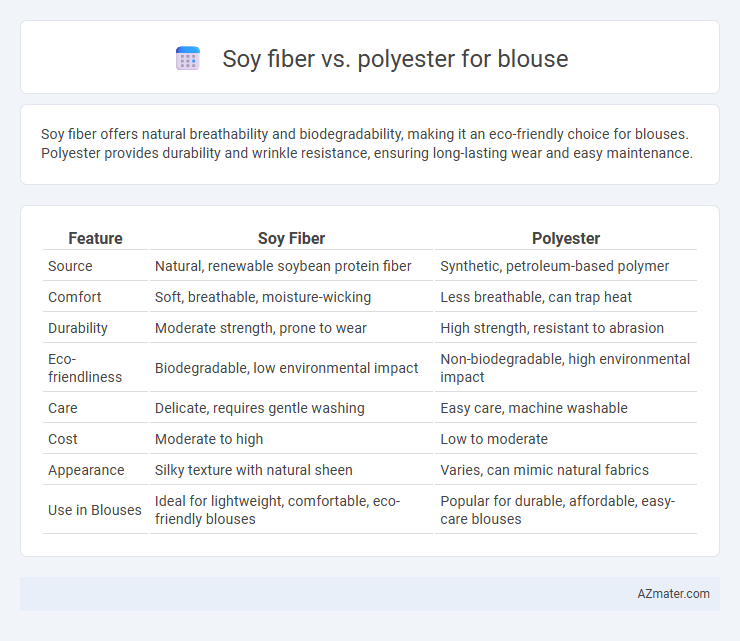Soy fiber offers natural breathability and biodegradability, making it an eco-friendly choice for blouses. Polyester provides durability and wrinkle resistance, ensuring long-lasting wear and easy maintenance.
Table of Comparison
| Feature | Soy Fiber | Polyester |
|---|---|---|
| Source | Natural, renewable soybean protein fiber | Synthetic, petroleum-based polymer |
| Comfort | Soft, breathable, moisture-wicking | Less breathable, can trap heat |
| Durability | Moderate strength, prone to wear | High strength, resistant to abrasion |
| Eco-friendliness | Biodegradable, low environmental impact | Non-biodegradable, high environmental impact |
| Care | Delicate, requires gentle washing | Easy care, machine washable |
| Cost | Moderate to high | Low to moderate |
| Appearance | Silky texture with natural sheen | Varies, can mimic natural fabrics |
| Use in Blouses | Ideal for lightweight, comfortable, eco-friendly blouses | Popular for durable, affordable, easy-care blouses |
Introduction to Soy Fiber and Polyester
Soy fiber, derived from soybean protein, offers a sustainable and biodegradable alternative to traditional textiles, prized for its softness, breathability, and moisture-wicking properties in blouses. Polyester, a synthetic polymer made from petroleum-based products, is known for its durability, wrinkle resistance, and quick-drying characteristics, making it a popular choice for blouses requiring low maintenance. Comparing both fibers reveals that soy fiber provides eco-friendly comfort and natural texture, whereas polyester delivers strength and easy care for everyday wear.
Origin and Production Processes
Soy fiber, derived from the byproducts of soybean processing, is a natural, biodegradable textile known for its eco-friendly production involving the extraction of proteins from soybeans and their conversion into fibers through processes like wet spinning. Polyester, a synthetic fiber originating from petrochemicals, is produced through polymerization of purified terephthalic acid and monoethylene glycol, resulting in a durable and wrinkle-resistant fabric. The contrasting origins--renewable plant-based soy versus petroleum-based polyester--lead to significantly different environmental impacts and textile qualities.
Environmental Impact Comparison
Soy fiber, a biodegradable and renewable resource derived from soybean protein, offers significant environmental benefits by reducing reliance on petroleum-based materials and lowering greenhouse gas emissions during production. Polyester, a synthetic fiber made from non-renewable petroleum, contributes to microplastic pollution and requires high energy consumption and chemical treatments, resulting in a larger carbon footprint. Choosing soy fiber for blouses supports sustainable fashion initiatives by promoting resource efficiency and minimizing long-term environmental harm.
Comfort and Feel: Which Is Softer?
Soy fiber is renowned for its exceptional softness, often compared to silk, offering a smooth and breathable texture that enhances blouse comfort. Polyester, while durable and wrinkle-resistant, tends to be less breathable and can feel less soft against the skin due to its synthetic nature. Choosing soy fiber for a blouse provides a naturally soft, moisture-wicking fabric ideal for comfort, whereas polyester may retain heat and feel less gentle during prolonged wear.
Breathability and Moisture Management
Soy fiber offers superior breathability compared to polyester, allowing air to circulate freely and keeping the skin cool and dry. Its natural moisture-wicking properties absorb sweat efficiently, enhancing comfort during warm weather. Polyester, while durable, tends to trap heat and moisture, often leading to a less breathable and less comfortable fabric choice for blouses.
Durability and Longevity
Soy fiber offers moderate durability with natural biodegradability but may wear out faster than synthetic fibers under frequent use, making it less ideal for long-term blouse wear. Polyester provides superior durability and resistance to stretching, shrinking, and abrasion, ensuring prolonged longevity and retention of shape in blouses. Blouses made from polyester maintain color vibrancy and structural integrity over repeated wash cycles, outperforming soy fiber in durability and lifespan.
Care and Maintenance Requirements
Soy fiber blouses require gentle hand washing with mild detergent and air drying to maintain their softness and prevent shrinkage, while polyester blouses are machine washable, quick-drying, and resistant to wrinkles, making them easier to care for in everyday use. Soy fiber's natural properties demand more delicate handling to avoid damage, whereas polyester's synthetic composition provides durability and resistance to chemicals and stains. Choosing between the two depends on whether ease of maintenance or natural fiber benefits are prioritized.
Allergenicity and Skin Sensitivity
Soy fiber, derived from natural soy protein, offers hypoallergenic properties that reduce the risk of skin irritation and allergic reactions, making it an ideal choice for sensitive skin in blouse fabrics. Polyester, a synthetic fiber, can trap heat and moisture, potentially aggravating skin sensitivity and causing discomfort or rashes in individuals prone to allergies. Choosing soy fiber blouses enhances comfort and skin health due to its natural breathability and softness compared to the less skin-friendly polyester options.
Cost and Market Availability
Soy fiber blouses generally cost more than polyester due to their natural origin and sustainable production methods, appealing to eco-conscious consumers. Polyester is widely available and often produced at a lower cost, making it the dominant choice in mass-market blouse manufacturing. Market availability favors polyester because of its durability, ease of care, and extensive supply chain infrastructure.
Which Is Better for Blouses?
Soy fiber offers superior breathability, moisture-wicking, and softness, making it ideal for blouses intended for comfort and natural feel. Polyester provides enhanced durability, wrinkle resistance, and color retention, which benefits blouses requiring long-lasting structure and easy maintenance. For blouse wearers prioritizing eco-friendliness and skin comfort, soy fiber is better, while polyester suits those seeking practicality and resilience.

Infographic: Soy fiber vs Polyester for Blouse
 azmater.com
azmater.com